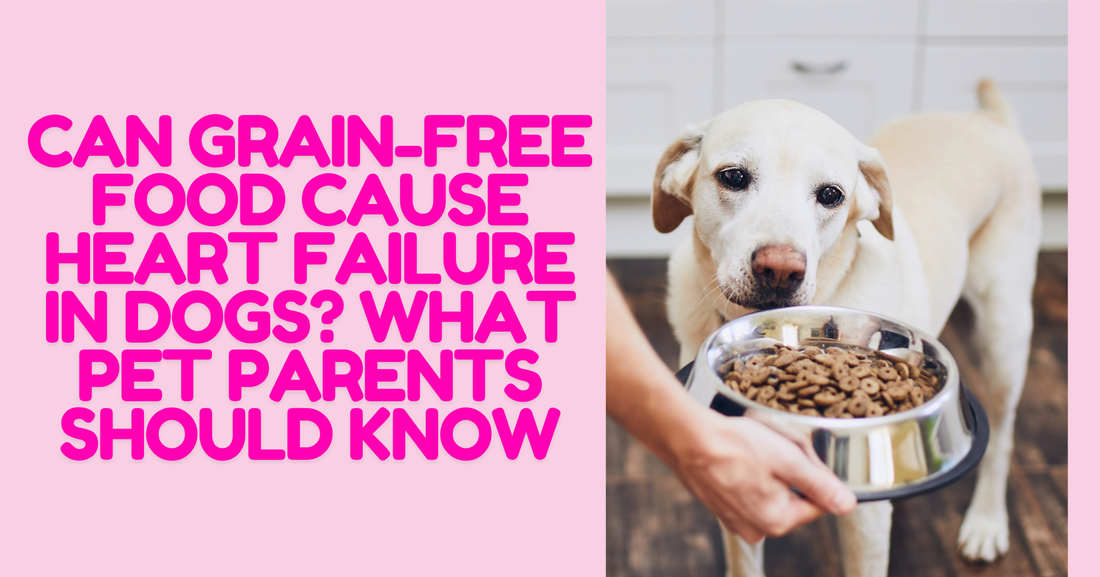
Can Grain-Free Food Cause Heart Failure in Dogs? What Pet Parents Should Know
Share
❤️ Can Grain-Free Food Cause Heart Failure in Dogs? What Pet Parents Should Know
If you’ve seen viral TikToks or news headlines warning that “grain-free food causes heart failure in dogs,” you’re not alone. Many pet parents are confused and worried about whether they’re doing the right thing for their pups.
So, what’s the truth? Let’s clear up the confusion with what science says, what the FDA found, and what this means when choosing safe, healthy treats.
⚠️ Where the Concern Came From
In 2018, the FDA began investigating a possible link between certain grain-free diets and cases of dilated cardiomyopathy (DCM), a form of heart disease.
The key detail:
- Dogs affected were often eating grain-free kibble where peas, lentils, and legumes were used in high amounts as substitutes for grains.
- These ingredients may interfere with taurine, an amino acid essential for heart health.
🌾 Is Grain-Free Itself the Problem?
No. The issue isn’t the absence of grains... it’s the fillers that replaced them.
Common grains in dog food include:
- Wheat
- Corn
- Rice
- Barley
- Oats
- Soy
Common legumes used as fillers include:
- Peas
- Lentils
- Chickpeas
- Beans
👉 The FDA concern wasn’t that removing grains is harmful. The problem came when brands swapped grains for large amounts of legumes and starches instead of using quality proteins.
When made with balanced, species-appropriate ingredients, grain-free diets and treats can be perfectly safe.
🐾 What About Grain-Free Treats?
Here’s the important difference:
-
The FDA’s concern focused on complete diets (like kibble) fed as a dog’s sole nutrition source.
-
Occasional grain-free treats are not the same as replacing a dog’s full diet.
In fact, grain-free treats can often be gentler on dogs with allergies or sensitive stomachs; if they’re made with clean, limited ingredients.
🥩 How Owa Owa Does Grain-Free Differently
At Owa Owa, all of our treats are grain-free by design, but we don’t cut corners with fillers. Instead, we focus on:
-
Human-grade, single proteins → chicken, beef, turkey, salmon.
-
Functional add-ins → goat milk yogurt, pumpkin, blueberries.
-
No legumes or cheap starch substitutes.
Examples:
-
Meatzapawn → turkey + goat milk yogurt.
-
Gold Fishies → wild sockeye salmon + turmeric.
-
Pup Noodles™ → all-meat ramen noodles made from chicken or beef + veggies.
Our philosophy is simple: dogs thrive on meat-based nutrition, not fillers.
💡 What Pet Parents Should Do
-
Don’t panic if you’ve fed grain-free treats. The FDA concern is about diets, not occasional snacks.
-
Always read ingredient labels — whether grain-free or not.
-
Choose brands that focus on quality proteins and transparency.
❤️ The Bottom Line
Grain-free food itself doesn’t cause heart failure in dogs. The concern comes from diets where grains were replaced with peas, lentils, and other fillers in high amounts.
At Owa Owa, we believe treats should be fun, safe, and nourishing. That’s why ours are grain-free for the right reason: to give dogs protein-rich, species-appropriate snacks that feel just as special as loving them.
👉 Explore our grain-free collection at owaowaco.com.
❓ Frequently Asked Questions
Q: Can grain-free food cause heart problems in dogs?
A: Some grain-free diets linked to heart issues used high levels of peas, lentils, and legumes. It’s not the lack of grains but the fillers replacing them that raised concern.
Q: Are grain-free treats safe?
A: Yes, especially when made with clean, limited ingredients. Owa Owa’s grain-free treats use proteins and vegetables, never legume fillers.
Q: Are Owa Owa treats grain-free?
A: Yes! All Owa Owa treats are grain-free, made with human-grade meats, simple vegetables, and functional add-ins like goat milk yogurt or pumpkin.
Q: Should I avoid grain-free diets altogether?
A: Talk to your vet about your dog’s specific needs. For most dogs, the key is balanced, high-quality ingredients, whether or not grains are included.
